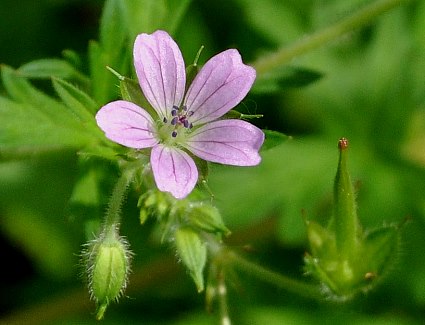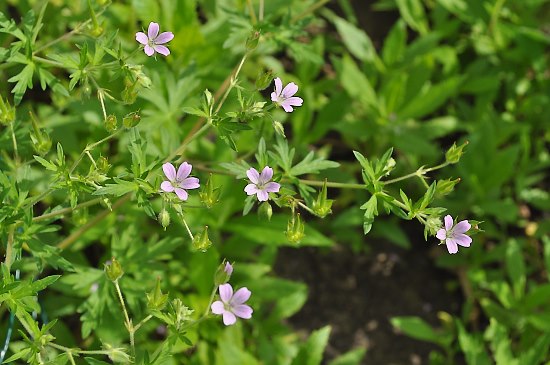Description: This annual or biennial wildflower develops ascending to sprawling stems about 1½–3' long. The stems are light green to reddish green and pubescent with short spreading hairs. Either opposite or alternate leaves occur at intervals along the stems; the leaf blades are up to 3" long and 3" across and deeply cleft into 3-5 palmate lobes. The leaf margins are sparingly dentate or further divided into small secondary lobes. The upper leaf surfaces are medium green and hairless (or sparingly so), while the their lower surfaces are pale green and pubescent. The petioles are light green and pubescent. At the base of each petiole, there is a pair of small linear stipules. From the axils of the middle to upper leaves, clusters of 2 or more flowers develop on slender pubescent stalks; these stalks are about ¾–1½" long at maturity.

Each flower is
about 1/3" (8 mm.) across, consisting of 5 light pink petals, 5 green
sepals,
10 stamens, and a pistil. Fine pink lines radiate from the throat of
each flower. The petals are oblong in shape and slightly notched at
their tips. The sepals are lanceolate to ovate and pubescent; each
sepal has an awn-like tip about 1.5 mm. long. The blooming period
occurs during the summer and lasts about 2 months. Usually, only a few
flowers are in bloom at the same time. Each flower is replaced by a
narrow columnar fruit about ½–¾" long that tapers to a short beak. At
maturity, the fruit splits open into 5 slender sections from the
bottom, remaining connected together at the apex. By this process, the
seeds are mechanically ejected from the mother plant.
Cultivation:
The preference is partial sun, mesic to dry-mesic conditions, and cool
to warm summer temperatures. Different kinds of soil are tolerated,
including those that are sandy or rocky.
Range & Habitat:
Northern Cranesbill is restricted to NE Illinois, where it is rare and
native to the area (see Distribution
Map). This species is state-listed as 'endangered.' Illinois
lies at the southern range-limit of this boreal wildflower. Habitats
include woodland openings, sandy Black Oak woodlands, typical and sandy
savannas, and rocky outcrops. This wildflower becomes more abundant
after a wildfire; there is some evidence that its seeds germinate in
response to heat and/or light.

Faunal
Associations:
The flowers are pollinated by small flies (particularly Syrphid flies)
and small bees (particularly Halictid bees). Both nectar and pollen are
available as floral rewards to such visitors. One insect that sucks on
the juices of Geranium spp. is Macrosiphum
geranii (Geranium Aphid). The seeds of some Geranium
spp. are eaten by such birds as the Mourning Dove and
Bobwhite Quail to a limited extent.
Photographic Location:
A nature preserve in Cook County, Illinois. The photographs were taken
by Lisa Culp (Copyright © 2009).
Comments:
This is one of several annual or biennial Geraniums (Geranium spp.) in
Illinois. The majority of these species have been introduced from
Eurasia, although some of them are native. All of these species have
relatively small flowers, palmately cleft simple leaves (see exception
below), and a sprawling to ascending habit. As a result, they can be
difficult to distinguish from each other. Northern Cranesbill can be
identified through the following combination of characteristics: 1) It
produces small flowers (about 1/3" across) in clusters of 2 or more, 2)
the stems and stalks of the flowers are pubescent with short spreading
hairs, 3) the pedicels of the flowers/fruits are longer than the
sepals, and 4) the sepals have awn-like tips. One aberrant species in
this group, Herb Robert (Geranium
robertianum), differs from the others by its leaves, which
are palmately divided into leaflets with petioles.